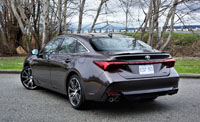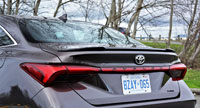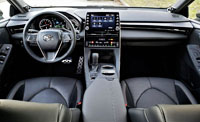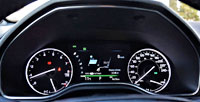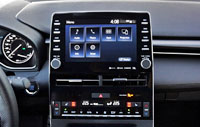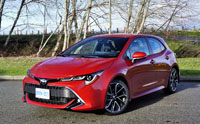
If you remember the Scion brand and its superb little iM compact hatch, which was transformed into the Corolla iM when the youth-oriented brand was unceremoniously discontinued a few years back, the new Corolla Hatchback is a direct descendant of both, and therefore should be high on the shopping lists of those who like practical, fun-to-drive, well-made five-door compacts.
For a bit of background, the 2016–2018 iM was much more refined than most of its competitors, mostly because it was in fact a renamed second-generation Toyota Auris from Europe, where the majority of automakers finish their compact cars nicer than the versions we can purchase here. On the other side of the globe in Australasian markets, this five-door Toyota had long been given the Corolla Hatchback name, so it made perfect sense to drop the iM moniker in place of a simpler, more familiar nameplate when this all-new hatch arrived here for the 2019 model year.
Although not as popular as its four-door sibling, the Corolla Hatchback’s well-proportioned face, including eye-catching standard LED headlamps, should be familiar now that the 2020 Corolla sedan is proliferating like its predecessor. I like both cars’ new look, but the sportier Hatchback gets a slightly more assertive nod of approval from yours truly, mostly due to my personal penchant for five-door compacts.
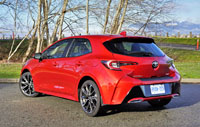
Interestingly, I’d take Honda’s Civic sedan over the same trim in the hatchback model any day of the week, because the Corolla’s arch-nemesis arguably looks good as the former and awkward as the latter, but most would probably agree that Toyota currently has the styling lead for all body styles in the compact segment.
While the Corolla has no shortage of razor sharp angles its overall shape is more organic, causing me to claim it’ll probably hold up better over the test of time. I’ll also hazard to guess the Corolla’s styling plays heavily into its impressive resale value, the Hatchback’s second-place ranking in the 2019 Canadian Black Book’s Best Retained Value Awards only improved upon in its compact car category by Toyota’s own Prius hybrid. Then again, this superb result should also be attributed to this car’s excellent value proposition, Vincentric also honouring the model with its 2019 Best Value In Canada Award in the Compact Hatchback class.
Model 2019 Corolla Hatchback pricing starts at only $20,980 plus freight and fees, which makes the new car $1,770 less expensive than its 2018 Corolla iM predecessor, and trust me that this latest version is almost wholly better. Its standard auto on/off headlights are full LEDs compared to halogen projector lamps in the old car, while the old iM’s remote access has been upgraded with standard proximity keyless entry plus pushbutton start/stop in the Corolla Hatchback, this convenient feature not even on the menu before. Additionally, the outgoing car’s old-school handbrake lever was replaced with an electromechanical parking brake.
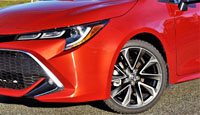
What’s more, the compact five-door’s advanced driver assistance systems have been enhanced from just providing auto-dimming high beam headlamps, automatic emergency braking, and lane departure warning to now boasting front pedestrian and bicycle detection, lane and road departure steering mitigation, as well as adaptive cruise control.
Features such as LED daytime running lights, LED turn signals integrated within the side mirror housings, LED taillights, a rear spoiler, cloth-wrapped A-pillars (another sign the iM/Corolla Hatchback came from Europe), glossy black and metal-like interior accents, a tilt and telescoping multifunction steering wheel, a 4.2-inch colour TFT multi-information display, variable intermittent wipers, an intermittent rear wiper, power windows with auto up/down all-round, and fabric sport seats continue forward.
Having touchscreen infotainment on top of the centre stack is retained as well, with a reverse camera, Bluetooth connectivity with phone and audio streaming, voice activation, plus a six-speaker AM/FM/USB/AUX audio system, but the all-new 8.0-inch display is an inch larger and integrates Apple CarPlay, Android Auto and Toyota’s proprietary Entune smartphone integration, which includes Entune App Suite Connect incorporating traffic, weather, sports, stocks, a fuel station locator, Slacker, Yelp, and NPR One, completely modernizing the new Corolla Hatchback.
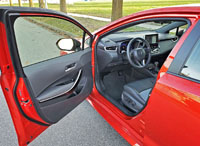
On the contrary, the previous iM’s standard 17-inch alloy rims have been replaced with a comparatively lacklustre set of 15-inch steel wheels with full covers in base trim, while its leather-wrapped steering wheel and shift knob are now urethane, two-zone auto climate control now single-zone (but still automatic), heatable front seats now optional, and the list goes on and on. All of these downgrades remind us that Scion was a single-trim, no options (just accessories) brand, meaning its cars were always well equipped in their “base” trims, but their starting prices weren’t always the most affordable in their segments, and prospective buyers couldn’t add fancier features like factory wheels, fog lights, a nicer gauge cluster, embedded navigation, leather upholstery, and more.
The new Corolla Hatchback has no such problems, which can easily be seen by eyeing up its front fog lights and sharp looking machine finished 18-inch alloys. These are standard in my test car’s top-tier XSE trim, but ahead of delving into all its details I should give you a breakdown of the 2019 Corolla Hatchback’s lesser trim packages.
If a rev-matching six-speed manual isn’t on your priority list, just add a modest $1,000 to the bottom line for Toyota’s impressive Direct-Shift continuously variable transmission (CVT) boasting sequential shift mode, while this upgrade also includes full-speed adaptive cruise control and lane tracing assist at no additional charge.

No matter the transmission, Toyota offers three Corolla Hatchback packages above the base car, including the $1,600 SE, $3,000 SE Upgrade, and $6,000 XSE, all of which can be verified right here at CarCostCanada, where you can also find the latest rebate info and dealer invoice pricing that could save you thousands (CarCostCanada was also showing factory leasing and financing rates from 0.49 percent at the time of writing).
The SE, that increases the Corolla Hatchback’s price to $22,580 for the manual or $23,160 with the CVT, adds 16-inch alloys, some chrome trim on the rear bumper, a leather-clad steering wheel rim, a powered driver’s seat with two-way power lumbar support, heated front seats, a theft deterrent system, and steering wheel-mounted shift paddle with the CVT, while the SE Upgrade package, which pushes the price up to $23,980 for the manual or $24,160 with the CVT, includes heat for the steering wheel rim, plus a wireless device charger, blind spot monitoring, and the aforementioned 18-inch alloy wheels.
Top-line XSE trim starts at $26,980 for the manual and $27,980 with the CVT, includes those LED fog lamps noted earlier, a much larger 7.0-inch TFT digital driver’s display, Sport fabric upholstery with leatherette trim, the dual-zone auto climate control system, Entune 3.0 Premium Audio that includes embedded navigation (with map updates for three years), traffic and weather info, Entune Destination Assist (with a six-month subscription), satellite radio, and Entune Safety Connect with automatic collision notification, a stolen vehicle locator, an emergency assistance (SOS) button, and enhanced roadside assistance.
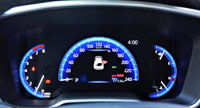
A shortlist of dealer-added accessories worthy of your attention include a $650 dash camera, a $155 cargo liner, an $80 cargo net, and $250 doorsill plates, while you can dress up the Corolla Hatchback’s exterior a super sporty extended rear rooftop spoiler for $535.
The Corolla Hatchback is as good looking and well constructed inside as outside, with no shortage of soft, pliable composites covering the dash, the inside section of the lower console, the front door uppers, plus the side and centre armrests. The mostly dark grey interior gets stylish light grey contrast stitching highlights in all the right places, while the sport seats noted earlier receive identical coloured contrasting thread as well as special medium grey cloth inserts. The two-tone seats’ two-temperature heaters warm quickly, and can be set to do so automatically every time the car is restarted, as can the heated steering wheel rim that made my Corolla Hatchback tester a lot more enjoyable to live with.
Unfortunately Toyota doesn’t add the light-grey contrast stitching to that steering wheel rim, but its thick leather wrapping is ideally shaped for performance driving, and therefore feels good in the palms and fingers whether hot or cold, while the telescopic steering column offers ample reach, allowing me to position the driver’s seat perfectly for my long-legged, short torso body, which wasn’t possible with the iM. Keeping comfortable and supported, the Hatchback’s two-way powered lumbar found the small of my back reasonably well, although it would’ve been even better if slightly lower. Obviously taller fellas will disagree, but such is the challenge with two-way lumbar support.
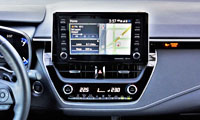
With the steering wheel and seat set exactly as required, the bright primary gauge cluster is easy to see. It gets the usual assortment of dials, including a tachometer, speedometer, fuel and temperature meters, the first formed from a semicircle at the very left, the second arcing over the largest middle display, and the latter two combining into another semicircle at the right. The digital speedometer wraps around a multi-info display, complete with trip, fuel economy, cruise info and more, all prompted by a well-organized set of high-quality steering wheel switchgear.
The new infotainment touchscreen is fixed upright above the centre stack like so many others these days, and includes a row of analogue buttons down the sides, plus a power/volume and tune/scroll knob at the base of each. The display responds to tap, swipe and pinch gestures quickly, this particularly useful for the navigation map that’s otherwise beautifully clear and easy to read, this because of a high-resolution screen that also aids the rearview camera’s clarity. The system’s colours are nice and contrast good, but the graphics are more functional than artistic.

If you’ll grant me some creative license, I’d say the Corolla Hatchback’s wonderfully agile suspension borders on artistry, or at least makes a decent driver feel like an artist. Unlike some in the compact class, including the old Corolla sedan, the new Corolla Hatchback (and new 2020 sedan) incorporates a fully independent suspension with a multi-link setup in the rear, this also true of the Corolla iM. The independent rear suspension (IRS) is part of the Toyota New Global Architecture (TNGA) platform architecture that underpins both new Corollas, making them two of the more engaging performers in the category. Also important to handling and safety, the TNGA platform’s torsional rigidity is 60-percent stiffer. This added rigidity is immediately noticeable on a twisting road, the increased structural strength allowing Toyota’s engineers to dial in more suspension compliance resulting in better adherence to the road over imperfect pavement, plus much improved ride quality even with its larger 225/40R18 Bridgestone tires.
While I never complained about the previously Corolla iM’s 16-valve, DOHC, 1.8-litre four-cylinder engine, as its free-revving 137 horsepower and 126 lb-ft of torque was ample for my needs and met my expectations in this class, the new Corolla Hatchback has made big gains in straight-line performance. Output is up by 31 horsepower and 25 lb-ft of torque to 168 horsepower and 151 foot pounds, and the direct-injection 2.0-litre mill is still plenty of fun to wind out. It’s easily enough power to offset the new Hatchback’s 1,388-kilogram (3,060-lb) curb weight, which is 118 kilos (260 lbs) more than the iM.
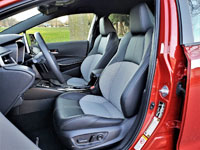
I had good things to say about the iM’s six-speed manual when first driving it, so I imagine Toyota has done a good job with the base transmission in the Corolla Hatchback too, while I was impressed with the old model’s CVT-S automatic, the “S” implying Sport, and for the most part living up to it. This said the new Corolla Hatchback’s Direct-Shift CVT is downright amazing, with truly fast, snappy shifts when set to Sport mode. It features 10 pseudo gear ratios that feel much more realistic than any CVT previously tested, and those aforementioned paddles are truly worth flicking (unlike with most other CVTs), while it’s ultra-smooth when allowed to do its own thing, and improves fuel economy too.
Even though it puts out more power and moves a car that weighs more, the new Corolla Hatchback delivers better fuel economy than the old iM, with a claimed 7.5 L/100km in the city, 5.8 on the highway and 6.7 combined compared to 8.3 city, 6.5 highway and 7.5 combined. The new Toyota’s manual gearbox is easier on the budget too, with a rating of 8.4 L/100km city, 6.3 highway and 7.5 combined compared to 8.8, 6.8 and 7.9 respectively.

So I mentioned the Corolla Hatchback is heavier than the iM, right? That’s at least partially due to being larger in almost every outward dimension, the Corolla Hatchback stretching 100 millimetres (3.9 inches) farther from nose to tail than the iM, with a 40-mm (1.6-in) longer wheelbase, and 30 mm (1.2 in) wider, while it’s just 25 mm (1.0 in) lower overall, but strangely its increased footprint doesn’t mean its bigger inside. On the contrary, while the Corolla Hatchback’s front legroom, rear headroom and rear shoulder room were fractionally increased by 7 mm (0.3 in), 2 mm (0.1 in) and 10 mm (0.4 in) apiece, the car’s front headroom is lower by 33 mm (1.3 in), its front shoulder room narrower by 10 mm (0.4 in), and its rear legroom shorter by 71 mm (2.8 in), while cargo area behind the rear seats is a shocking 14-percent less generous, shrinking from 588 litres (20.8 cubic feet) to a mere 504 litres (17.8 cubic feet).
Just the same I found it plenty roomy and wholly comfortable in every outboard position, but consider for a moment that I’m only five-foot-eight, so bigger people might want to thoroughly check out each seat before signing on the dotted line. Like the iM the Corolla Hatchback’s carpeted cargo floor is removable, exposing some added stowage and a compact spare tire underneath, while a 60/40-split divides the rear seatbacks when the need to add more cargo arises. Oddly, Toyota continues to make the Corolla Hatchback’s ultimate cargo capacity unknown, just like it did with the iM.

On the positive, the Corolla Hatchback gets the IIHS’ a best-possible “Good” rating in every category except “Crash avoidance & mitigation,” which only shows its headlamps managing “Acceptable” or “Marginal” capability, depending on trim or option, but keep in mind the IIHS is a U.S. agency testing the U.S.-spec Corolla Hatchback, which isn’t necessarily the same as ours in every way. Interestingly, the new Corolla Hatchback gets a rare “G+” rating in the NHTSA’s “LATCH ease of use” category, which means it should be easy for parents to strap in child safety seats, while this U.S. agency also gives the car a five-star safety rating.
How do I rate the 2019 Corolla Hatchback? How about four stars? After all, while it’s a great looking, well-built, nicely outfitted, fun to drive compact car, I was disappointed to find out it’s up in weight and simultaneously down on usable space when compared to its predecessor. It would certainly meet my mostly city driving needs, as my kids are grown and gone and I’m not toting around kayaks or towing dirt bikes anymore. I’m still young enough to have fun behind the wheel, however, and the new Corolla Hatchback is certainly up for that.
Story and photo credits: Trevor Hofmann


